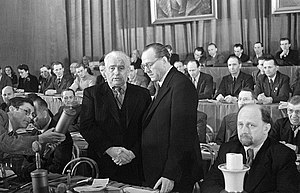
Back Zwangsvereinigung von SPD und KPD zur SED German Fusión del KPD y del SPD Spanish Fusion du Parti communiste d'Allemagne et du Parti social-démocrate d'Allemagne French Fusione del KPD e dell'SPD nel Partito Socialista Unificato di Germania Italian
 Pieck and Grotewohl shake hands during the unification ceremony | |
| Type | Unification treaty |
|---|---|
| Context | Merger of the KPD and SPD into the Socialist Unity Party of Germany |
| Signed | 21 April 1946 |
| Location | Admiralspalast, Berlin, Soviet occupation zone |
| Mediators | Soviet Union |
| Signatories |
|
| Parties | |
| Languages | German |
The East German branches of the Communist Party of Germany (KPD) and the Social Democratic Party of Germany (SPD) merged to form the Socialist Unity Party of Germany (SED) on 21 April 1946 in the territory of the Soviet occupation zone. It is considered a forced merger.[1] In the course of the merger, about 5,000 Social Democrats who opposed it were detained and sent to labour camps and jails.[2]
Although nominally a merger of equals, the merged party quickly fell under Communist domination. The SED became the ruling party of the German Democratic Republic (GDR) in 1949; by then, it had become a full-fledged communist party – for all intents and purposes, the KPD under a new name. It developed along lines similar to other Communist Parties in what became the Soviet Bloc. The SED would be the only ruling party of the GDR until its dissolution after the Peaceful Revolution in December 1989.
- ^ „Bei einer generellen Beurteilung ist »Zwangsvereinigung« der richtige Begriff. Er macht klar, dass es für die Sozialdemokraten in der SBZ damals keine Alternative gab. Sie befanden sich in einer Zwangssituation, denn unter sowjetischer Besatzung hatten sie keine freie Entscheidung darüber, ob sie dort die SPD fortführen wollten oder nicht.” Hermann Weber, Demokraten im Unrechtsstaat. Das politische System der SBZ/DDR zwischen Zwangsvereinigung und „Nationaler Front“, in: Das politische System der SBZ/DDR zwischen Zwangsvereinigung und Nationaler Front, 2006, S. 26. Auch Heinrich August Winkler schreibt, „daß der Begriff «Zwangsvereinigung» der Wahrheit nahekommt“ (zitiert n. ders., Der lange Weg nach Westen, Bd. 2. Deutsche Geschichte vom „Dritten Reich“ bis zur Wiedervereinigung, C.H. Beck, München, 4. Aufl. 2002, S. 125).
- ^ Halb faule Lösung: Die große Koalition verbessert nach heftiger Kritik die Opferpensionen für Verfolgte des DDR-Regimes. Focus 24/2007, S. 51.
© MMXXIII Rich X Search. We shall prevail. All rights reserved. Rich X Search